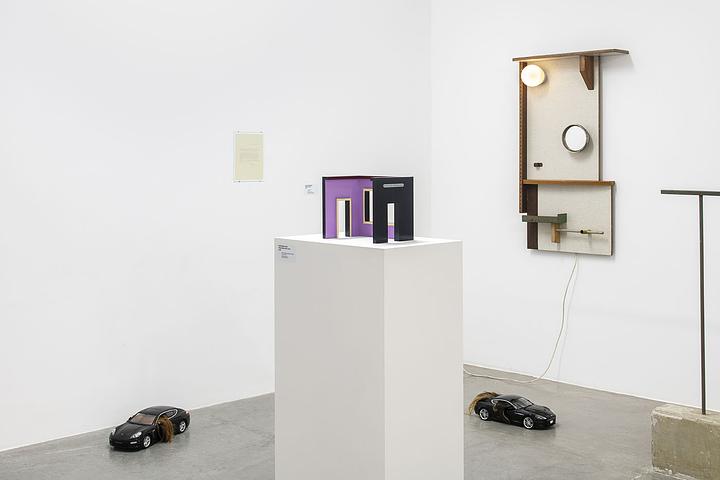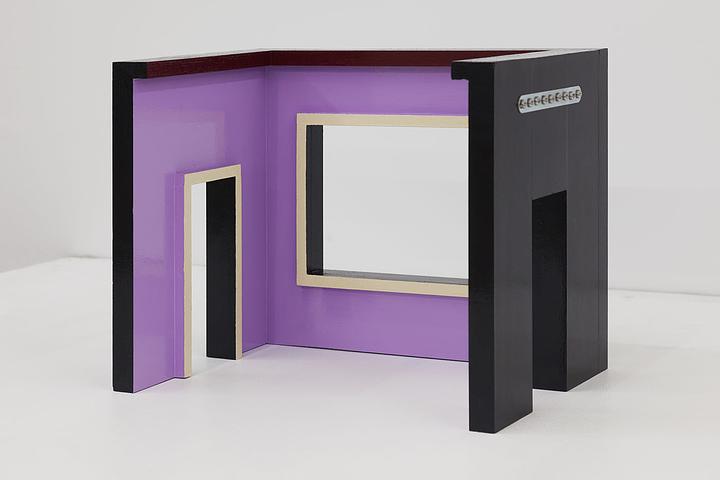Organized by Benoît Maire
Le Plateau, FRAC Ile-de-France, Paris, France
Organized by Benoît Maire
Organized by Benoît Maire

Foncteur d’oubli, organized by Benoît Maire, 2019
Le Plateau FRAC, Ile-de-France, Paris, France
Installation view

Naoki Sutter-Shudo
Room (violet with a view), 2018
Wood, enamel, zinc-plated steel, stainless steel
25.5 x 32 x 21 cm (10 1/8 x 12 1/2 x 8 1/4 in)
Artists: Nina Beier, Karina Bisch, Théophile Blandet, Nicolas Boone, Marcel Broodthaers, Maurizio Cattelan, Etienne Chambaud, Bastien Cosson, Eric Croes, Jean Derval, Nathanaël Dorent, Simon Dybbroe Møller, Diego Giacometti, Eileen Gray, Michel Herreria, Anne Holtrop, Agata Ingarden, Cooper Jacoby, Tarik Kiswanson, Max Lamb, Marie Lund, Robert Mallet-Stevens, Martinez Barat Lafore Architectes, Mélanie Matranga, Orta Miklos, Julien Monnerie, Cécile Noguès, Christopher Orr, Rikkert Paauw, Gaetano Pesce, Naoki Sutter-Shudo, Oscar Tuazon, Van Wassenhove Atelier, Octave Vandeweghe, Raphaël Zarka, natural expressions, ceramics from a private collection.
Benoît Maire gathers artists, designers and architects in an exhibition that considers, based on customary use, relationships between art and design and architecture, reviewing the premise that the arts are free and design objects are subject to constraints – due to their functional purpose.
The title of the exhibition Foncteur d’oubli, referring to a mathematical operation, forgetful functors, that shifts objects from one category to another by ‘forgetting’ certain properties, reflects the permeable boundaries between objects of art, design and architecture and how their classification can change, particularly with regard to this principle of functionality.
Starting from designers and architects related to the modernist movement, such as Eileen Gray and Robert Mallet-Stevens, combining aesthetic research and demands for functionality in a pursuit for the idea of the complete artwork and from their influence on many contemporary artists following these 20th century historical avant-gardes, the exhibition presents the fluid nature of the disciplines and draws attention to their similarities through Ker-Xavier’s architectural layout.
Young designers taking part in the exhibition emphasise the creative dimension of design and the unique and non-reproducible character of certain pieces that therefore resemble works of art.
The artists, for their part, focus on everyday objects, blur boundaries and highlight the ambiguity of our relationship with consumer goods (Simon Dybbroe Møller, Nina Beier), promote the functional or decorative dimension of the work and its relation to serial production or arts and crafts (Karina Bisch, Eric Croes), or investigate the essence of the work of art in relation to natural objects (Etienne Chambaud), examining the repetition of forms in the history of art (Raphaël Zarka).
Likewise, architects focus their attention on knowledge of materials, adapting their interpretation of public space to the private sphere and everyday uses.
Whether contemporary or historical, the objects gathered in the exhibition have been realized by creators with a shared interest in materials and gestures.